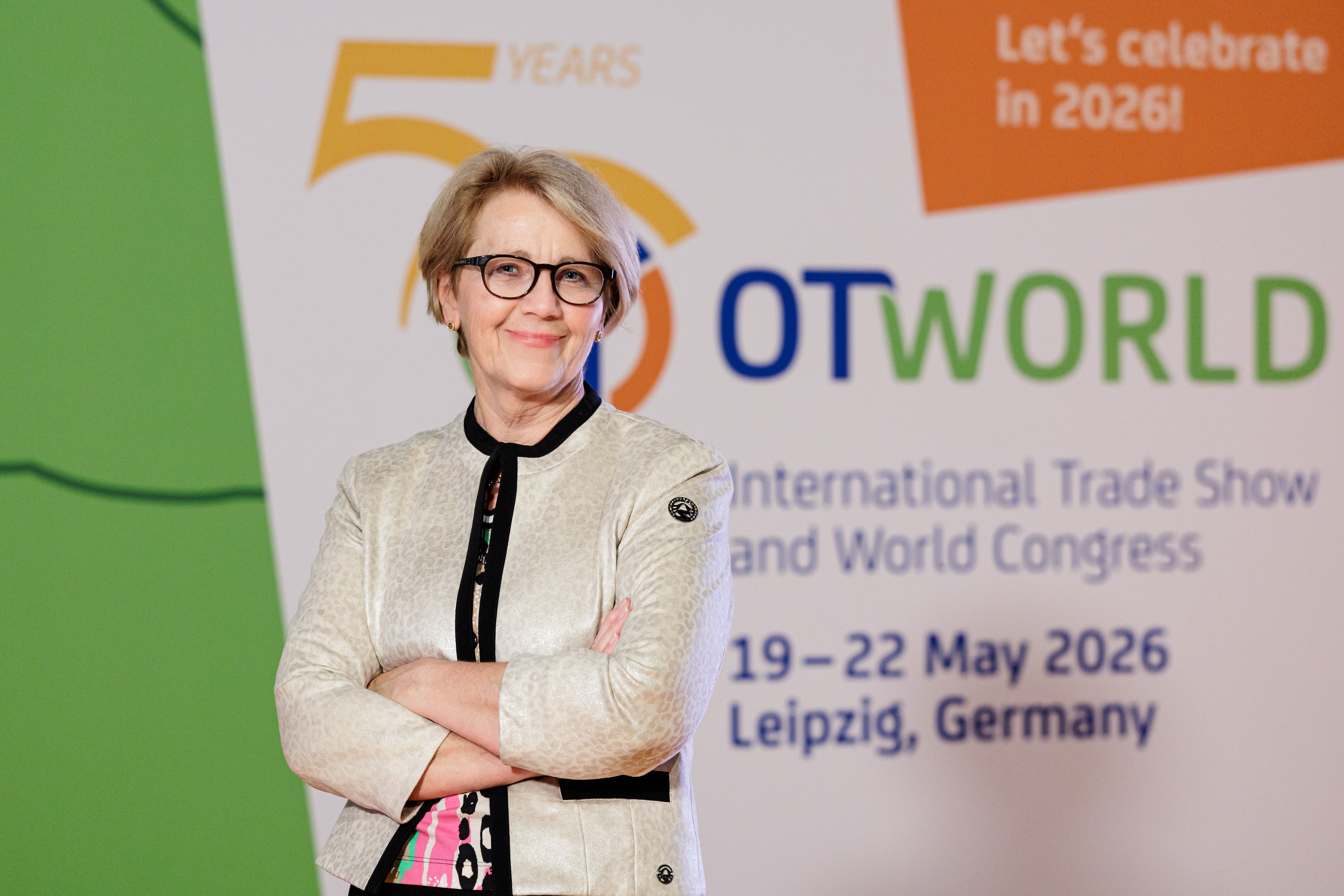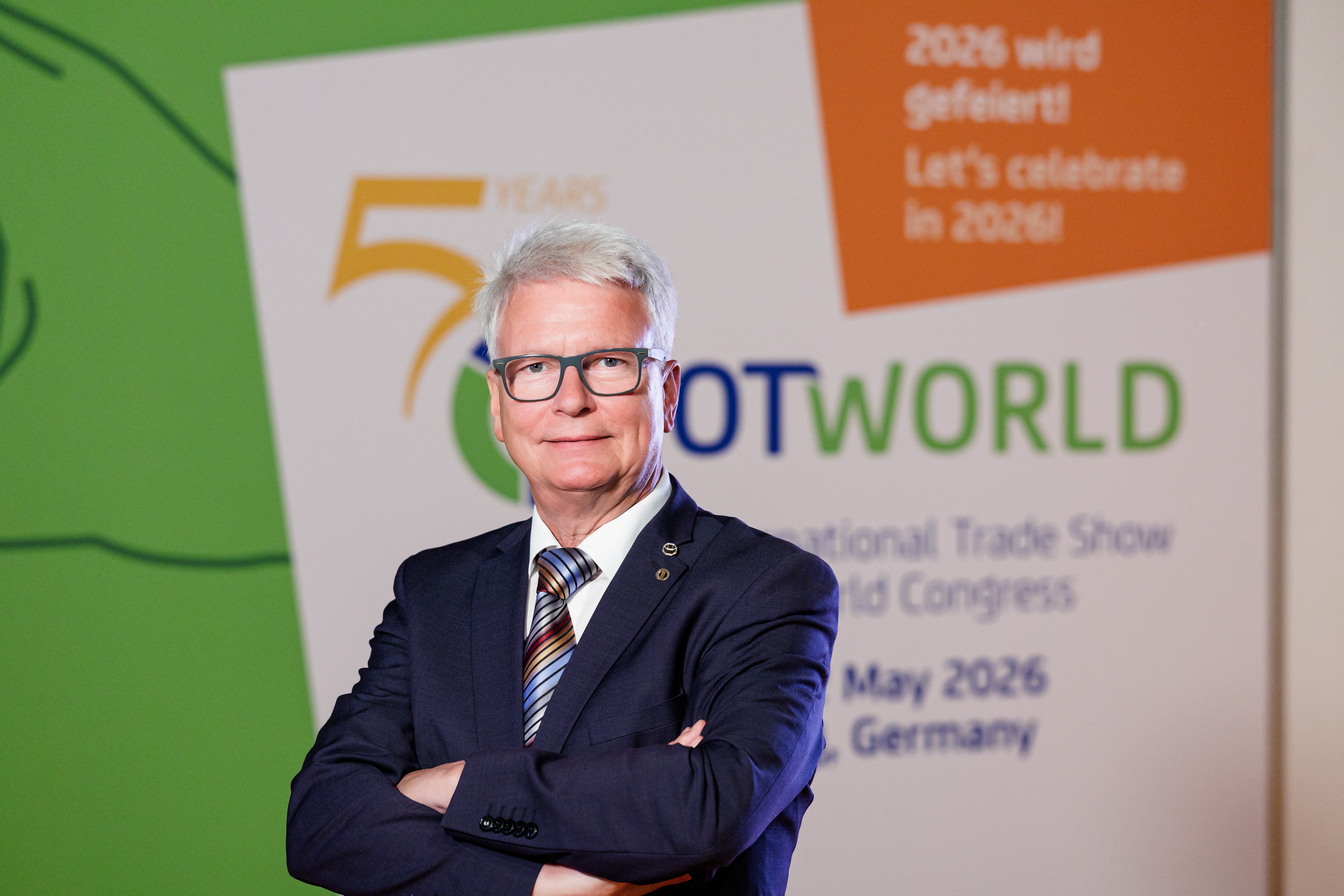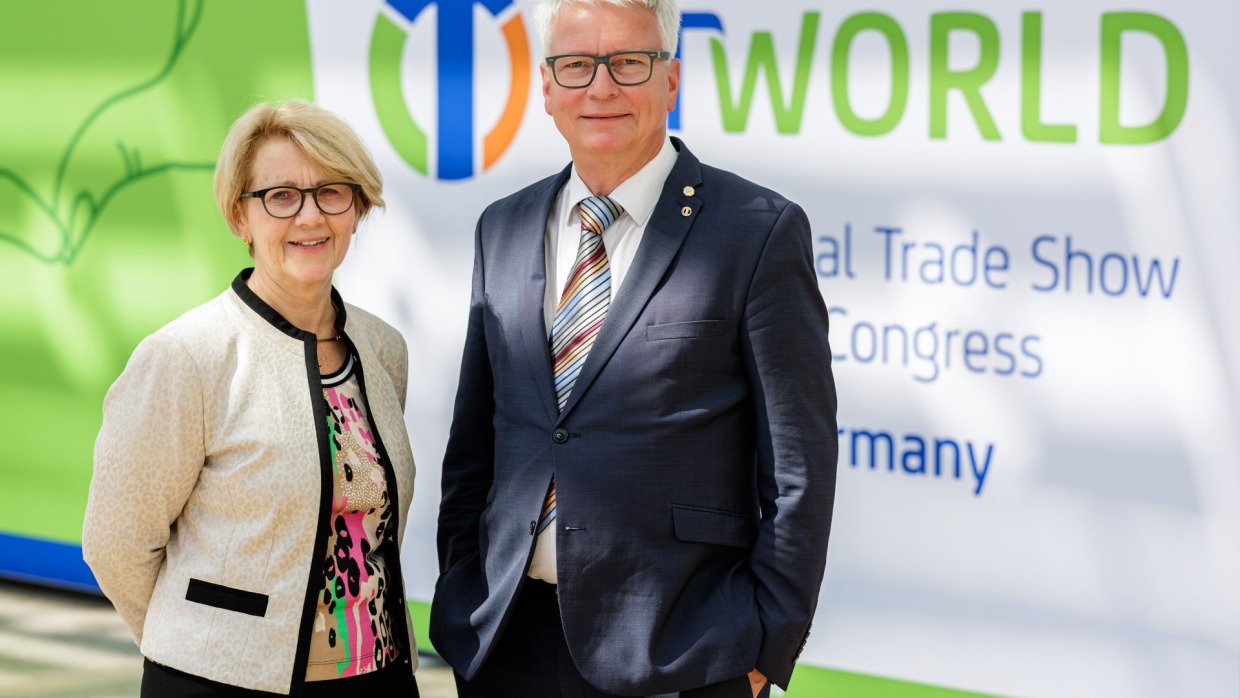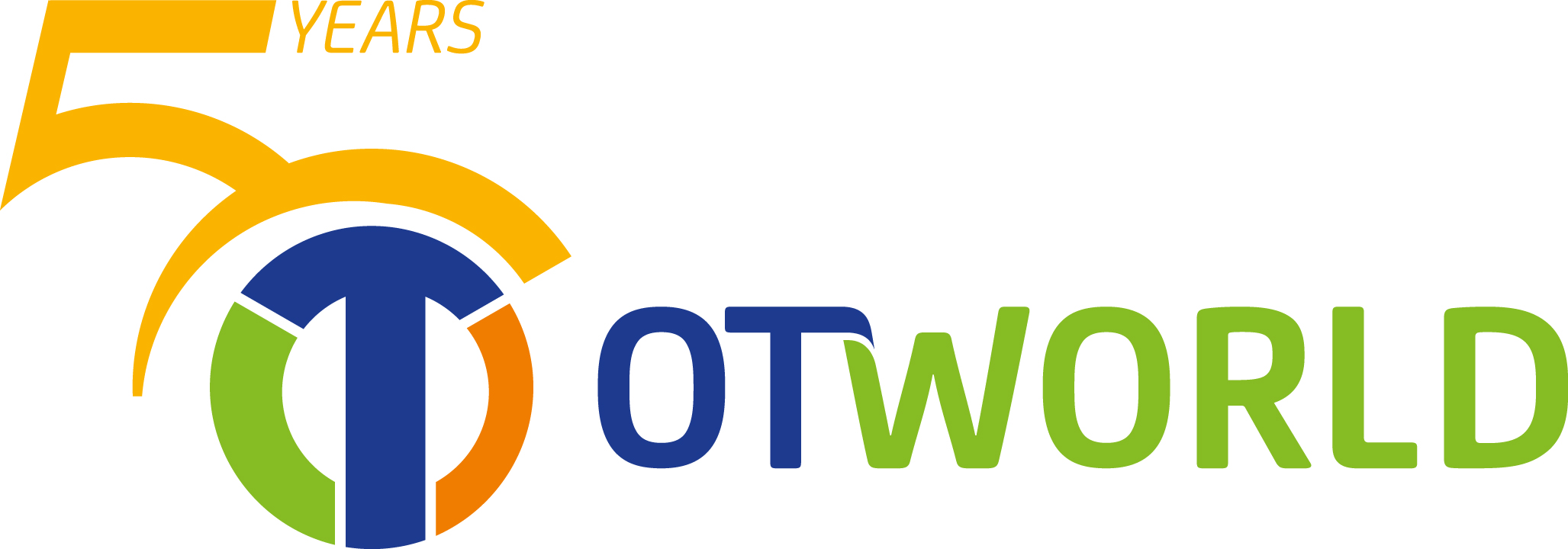OTWorld 2026: 50 years of joint progress for patients world-wide
Congress Presidents Dr Doris Maier and Thomas Münch discuss tradi-tion, change and responsibility in orthopaedic treatment and care.
From 19 to 22 May 2026, OTWorld in Leipzig will celebrate its 50th anniversary as the global meeting place for technical orthopaedics and everyone involved in modern assistive technology. For half a century, the World Congress and leading International Trade Show have been combining knowledge transfer, innovation and interdisciplinary orthopaedic treatment and care, for example with prostheses, orthoses, supports, compression stockings and wheelchairs.
To mark the anniversary, Congress Presidents Dr Doris Maier and Thomas Münch are shaping the content of the congress with their expertise and decades of experience. In this interview, they provide insights into their main areas of focus – and send a clear message: successful patient care can only be achieved through collaboration.
Thomas Münch, do you remember your first OTWorld?
Thomas Münch: How could I forget? In 1976, I was still in school, but thanks to my father, I was already attending O&R International – as the event was called at the time – in Düsseldorf. It was my first congress, much smaller than today – with an accompanying exhibition where we as visitors sometimes lent a hand ourselves. Together with some young colleagues, I even helped set up the Ottobock stand. And now, 50 years later, I am helping to organise OTWorld 2026 as Congress President – a very personal highlight in my life.
Dr Doris Maier, what particularly impressed you at your OTWorld premiere?
Dr Doris Maier: I remember it very clearly: I attended for the first time in 1997. I was overwhelmed by the broad range of medical aids and ideas in one place. You could strike up conversations everywhere and try everything out. For me, this open, curious interaction is still a hallmark of OTWorld to-day. I never would have dreamed that one day I would be one of the two Congress Presidents. It's a great honour!
Personal experiences as a guide for Leipzig
Mr Münch, which of your personal experiences do you draw on as congress president?
Thomas Münch: As an entrepreneur and master in prosthetics and orthotics, I know that plans often turn out differently than expected. The key is not to lose heart, to keep going and to give it your all – then you will find a way to achieve your goal. I bring this attitude to my role as Congress President.
Dr Doris Maier, to what extent do your experiences from your everyday work at the clinic influence your work as Congress President?
Dr Doris Maier: In my everyday work at the BG Unfallklinik, the focus is al-ways on ensuring the highest level of patient care – diagnostically, therapeutically and scientifically. This can only be achieved if we really reach everyone involved in the treatment: patients, employees and the entire team. Optimal care cannot be achieved alone, but only when physicians, therapists, prosthetists and orthotists, rehabilitation experts and health insurance companies work closely together. I would like to send this message very clearly at the World Congress. All the key players will come together in Leipzig – but not all of them are really pulling in the same direction yet.

Dr Doris Maier, which aspect of your work would you particularly like to highlight in Leipzig?
Dr Doris Maier: From my many years of work managing the Centre for Spi-nal Cord Injuries, I know that conservative orthopaedics is indispensable. It has a decisive influence on the quality of orthopaedic treatment and care. However, it has been somewhat overshadowed in the reformed advanced training of specialists in orthopaedics and trauma surgery. We must not ac-cept this. OTWorld offers us the opportunity to raise awareness of this area again and to jointly highlight the importance of conservative orthopaedics.
Training as the foundation for the future
Thomas Münch, you have put the topic of training and further education at the top of the agenda for the World Congress. Why is it so crucial for the future of prosthetics and orthotics right now?
Thomas Münch: Training has always been an issue, as the profession of prosthetists and orthotists has been constantly changing. During my training, for example, we still used plaster casts exclusively to create prosthetic sockets; today, scanning is increasingly used for this purpose. In the past, joints were adjusted with an Allen key, but today this is often done using software. Throughout my entire professional career, I have never experienced such rapid development as I am currently witnessing. We need to provide an-swers to this in our training programme – and give the next generation a strong foundation for the future, especially in the area of digitalisation.
Thomas Münch, how do you intend to strengthen training and further education?
Thomas Münch: Good training is like building a house. It starts with laying the foundations – the skilled trades. Because skilled trades skills are essential for manufacturing and adapting individual medical aids. Digitalisation is – to stay with the metaphor – the ground floor. On the first floor are the further training paths after the journeyman's certificate: the master craftsman's certificate or a bachelor's or master's degree. OTWorld therefore focuses on the question of how we want to shape skilled trades and academic training today and tomorrow: practical, digital, and interdisciplinary. Outside OTWorld, the Guild of Prosthetics and Orthotics for the Düsseldorf administrative district is promoting a model with its planned excellence training programme, which will challenge companies but produce highly qualified prosthetists and ortho-tists. We will present this excellence training programme at a separate symposium at OTWorld.

Thomas Münch, OTWorld is considered a meeting place for young talent. What do you offer to appeal specifically to young colleagues?
Thomas Münch: For young talent, OTWorld is the place where they can see and experience more than in any workshop. At the International Trade Show, they discover what is on offer worldwide. At the World Congress, experts discuss how national and international skilled trades and academic training can be structured today, and what improvements are possible or even necessary. In the workshop on interdisciplinary cooperation, young col-leagues also experience in a practical way how technicians, physicians and therapists work together on a treatment. This creates knowledge that can be used directly – and that is exactly what we need to make the next generation strong.
Focus on integrative care
Dr Doris Maier, what is your focus on integrative care?
Dr Doris Maier: I imagine care as a small universe: clinics, rehabilitation facilities, prosthetics and orthotics, therapists and cost bearers – each area is like its own planet circling the patient. Integrative care means that these planets see themselves as one system and work together so that the patient does not get stuck at interfaces or in waiting times. The focus is always on the patient and their treatment outcome. Only when everything is coordinat-ed do patients, professionals and the entire healthcare system benefit.
Dr Doris Maier, why did you place integrative collaboration at the centre of the programme?
Dr Doris Maier: The treatment of spinal cord injuries at our BG Unfallklinik in particular shows that ‘comprehensive care – everything from a single source’ is a recipe for success. Unfortunately, I often see patients getting lost at sector boundaries or interfaces, or not receiving optimal care. This is an enor-mous burden for those affected. That is why I want to use OTWorld to raise awareness of integrative care and promote networks.
Seamless collaboration for optimal patient care
Dr Doris Maier, your second focus is rehabilitation. Why is this topic so prominent at the World Congress right now?
Dr Doris Maier: Rehabilitation is one of the cornerstones that, alongside the best possible, guideline-compliant trauma surgery and orthopaedic diagnosis and treatment, determines the outcome for the patient. Good rehabilitation also requires an interdisciplinary team and timely, patient-centred treat-ment pathways. In many cases, prosthetics and orthotics play a significant role. In times like these, when the focus is often on optimising the cost-effectiveness of medical care, it is very important to me that we keep in mind the need for targeted rehabilitation as part of integrated care.
Dr Maier, what role does digitalisation play?
Dr Doris Maier: Digitalisation also opens up many new opportunities for us in rehabilitation. Modern systems can relieve the burden on specialists be-cause they facilitate documentation and information exchange. This creates the freedom we urgently need to work directly with patients. The numerous therapy apps and virtual therapies that have recently come onto the market enable our patients to access rehabilitation measures regardless of their location. This creates greater flexibility, especially when rehabilitation places are not immediately available. But one thing is important to emphasise: digi-tal offerings are only really helpful if they are individually tailored and ac-companied by specialists. Technology can support us – but the personal care and experience of our teams remain at the heart of successful rehabili-tation.
Prosthetics and orthotics between tradition and the future
Thomas Münch, what responsibility do prosthetists and orthotists and other specialist disciplines have towards patients – and how is this reflected at OTWorld?
Thomas Münch: Ultimately, it's always about the people who need our help – injured, sick and often severely impaired patients. They count on us to work together to provide them with the best possible care using medical aids and help them achieve the highest possible quality of life. To do this, doc-tors, technicians and therapists must speak the same language and closely coordinate their expertise. At OTWorld, we want to promote precisely this exchange – because we cannot afford to disappoint patients' expectations. I believe we all have a responsibility to deliver.
Thomas Münch, as a master prosthetist and orthotist, what highlights from prosthetics, orthotics and orthopaedic footwear technology would you recommend to participants?
Thomas Münch: I recommend that participants take a close look at the latest developments in prosthetic and orthotic joints for orthopaedic treatment and care concepts. In orthopaedic footwear technology, it is worth taking a look at the materials and the variety of possibilities. The digital innovations since OTWorld 2024 are also exciting – especially in the field of artificial in-telligence (AI). Despite all the digitalisation, the most important thing remains ‘NI – natural intelligence’. It cares for patients; everything else is just support.
Taking joint responsibility for the future
Dr Doris Maier and Thomas Münch, what message should the World Congress send to the world in its anniversary year?
Thomas Münch: For me, the message is: only when medicine, technology and therapy learn from and with each other can progress be made – and progress is the basis for even better orthopaedic treatment and care to patients locally and around the world. This interdisciplinary interaction is at the heart of the World Congress. This is ensured by the high-calibre programme and workshop committee, which is organising the congress programme together with Dr Doris Maier and myself. This is precisely the kind of coopera-tion that we have been practising in our prosthetics and orthotics business for three generations now, in close association with the BG Unfallklinik in Duisburg-Buchholz. That is why I appeal to all participants: bring your knowledge, your experience, your questions and your employees with you – only together can we make progress for patients.
Dr Doris Maier: I can only agree with Thomas Münch. Of course, the tech-nical innovations we see today in medicine and orthopaedic technology are a great asset. But even after 50 years, what still makes the difference is something else: highly qualified training and further education in all specialist disciplines, open exchange between disciplines and the joint struggle to find the best solution. Patient-centred treatment in an interprofessional team is the fundamental guarantee of therapeutic success. My work at the BG Un-fallklinik in Murnau confirms this every day.
About the person: Dr Doris Maier
Dr Doris Maier is a specialist in orthopaedics and physical therapy and has been Medical Director of the BG Unfallklinik Murnau since August 2025. Previously, she was Chief Physician at the Centre for Spinal Cord Injuries with Neuro-Urology at the clinic. There, she introduced a successful model of interprofessional collaboration. Her teams from trauma surgery/orthopaedics, neurology, respiratory and internal medicine, paraplegic therapy and specialist nursing staff work closely with prosthetists and orthotists to provide patients not only with the best possible medical care, but also a high quality of life.
About the person: Thomas Münch
Thomas Münch is a master orthopaedic technician and Managing Director of the long-established company Münch und Hahn in Duisburg, which has been working closely with the BG Unfallklinik accident clinic in Duisburg-Buchholz for decades. For over 25 years, he has shaped the sector as master craftsman and deputy master craftsman of the Guild of Prosthetics and Orthotics for the Düsseldorf administrative district and as a board member of the German Association of Orthopaedic Technology (BIV-OT). With the Münch Foundation, he is also committed to education and research in prosthetics and orthotics.
About OTWorld
The professional sponsor of OTWorld is the German Association of Orthopaedic Technol-ogy (BIV-OT). The organiser of the congress and owner of the OTWorld brand is Con-fairmed GmbH. Leipziger Messe GmbH is responsible for the trade show.

